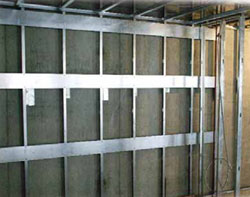Not an engineer, but thought I would try to answer your question - the blocking has a smaller surface area and a higher thermal mass than plywood.......the plywood is a smaller thermal mass thus absorbs heat at a faster rate and would allow the plywood through pryolysis to degrade, generate ignitable vapors, and ignite faster and quicker than a 2x4 blocking material.
Also, blocking is not continuous thus has built in fire stops... plywood doesn't.
Pyrolysis is usually the first chemical reaction that occurs in the burning of many solid organic fuels, like wood, cloth, and paper, and also of some kinds of plastic. In a wood fire, the visible flames are not due to combustion of the wood itself, but rather of the gases released by its pyrolysis, whereas the flame-less burning of a solid, called smouldering, is the combustion of the solid residue (char or charcoal) left behind by pyrolysis. Thus, the pyrolysis of common materials like wood, plastic, and clothing is extremely important for fire safety and firefighting.
Pyrolysis is a thermochemical decomposition of organic material at elevated temperatures in the absence of oxygen (or any halogen). It involves the simultaneous change of chemical composition and physical phase, and is irreversible.
The face of the plywood would be ex[posed on one side- either the internal stud cavity or to the room exposure.......type II construction limits the combustible products located within to make the building as fire resistant as possible without adding structural fire protection to the mix - (rule of thumb - type II-A does have limited structural protection within the design of the building)



